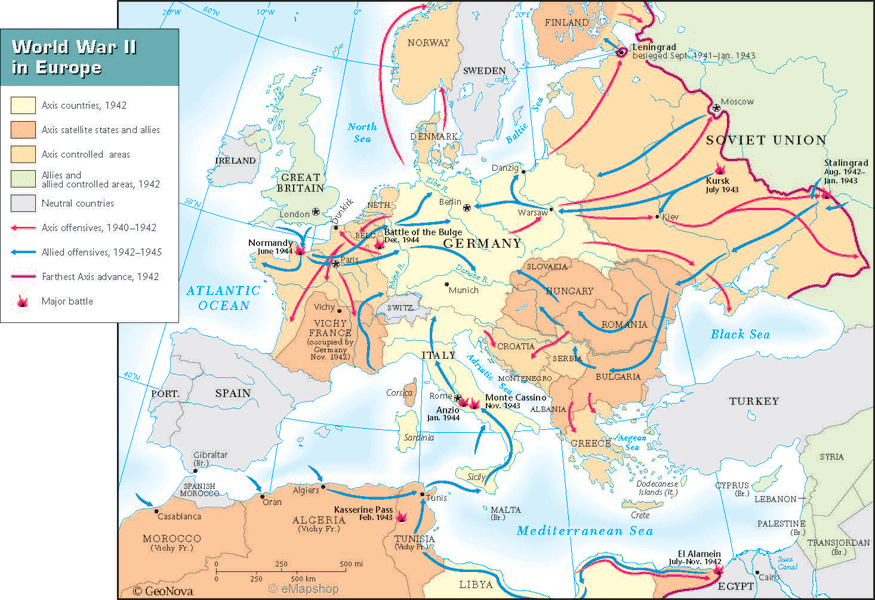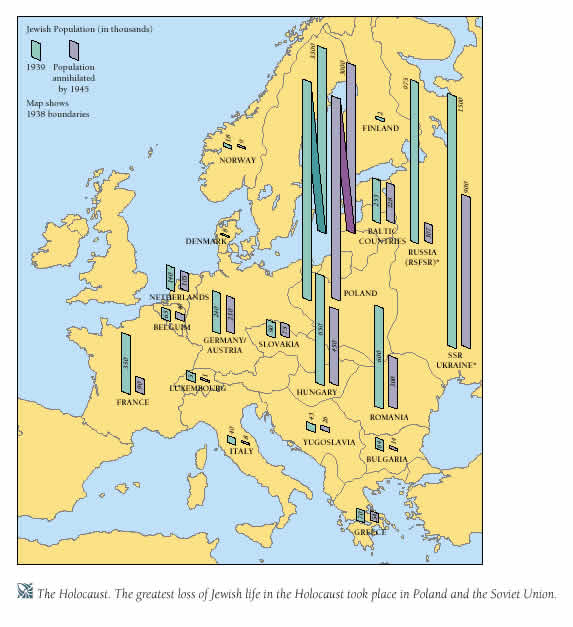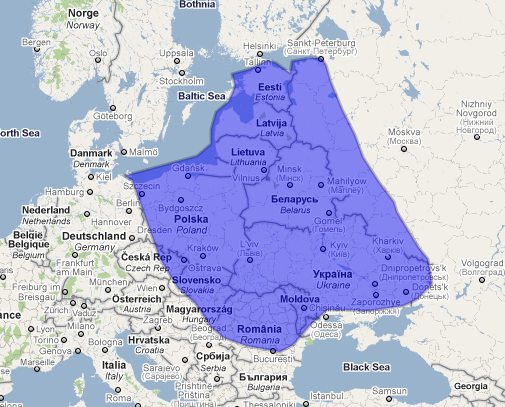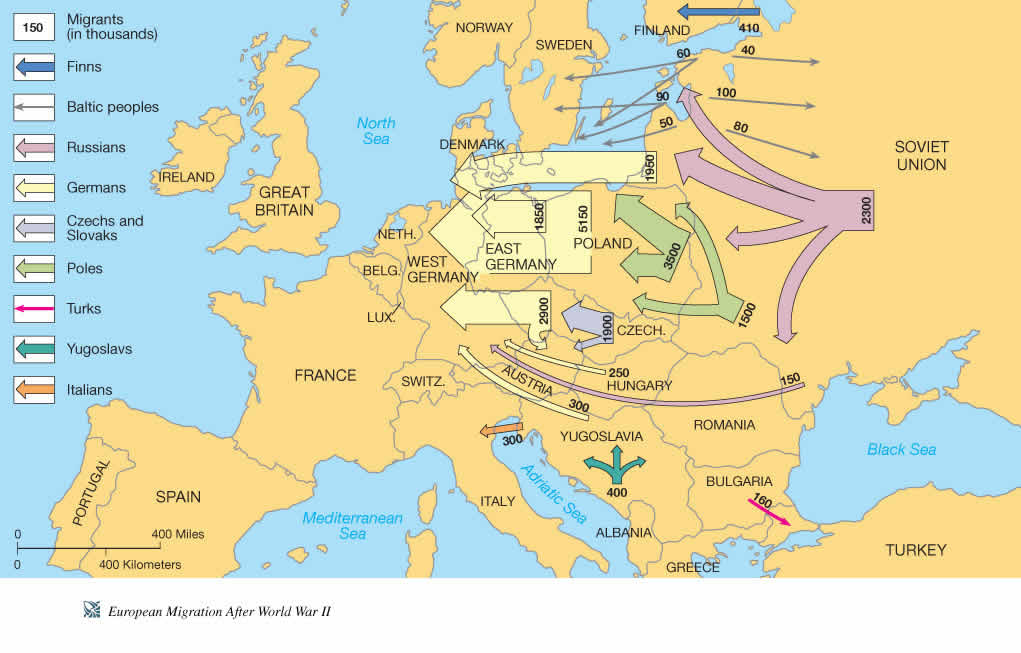World War, Carnage, Occupation, Genocide
1. The Course of Battle
2. The Eastern Front
3. Casualties
4. The Impact on Civilians (I): Occupation Policies
5. The Impact on Civilians (II): Genocide
6. The Impact on Civilians (III): Mass Flight and Expulsions
map: World War II in Europe

The original can be found at:
http://classroom.mapshop.com/HISTORY/US/World-War-II-in-Europe.asp
1939 September 1: Nazi invasion of Poland, war begins
“Blitzkrieg” =
lightning war
1. military technology: war of movement (not trench
warfare)
2. psychological impact: demoralize civilians ("the Blitz," phony war)
3. logistics: Nazis faced raw materials shortages (wheat, oil, iron ore)
1940 May-June: Germany defeats and occupies northern France
1941 June 22: Hitler declares war on USSR (“Operation Barbarossa”)
the western front:
Allied landings in west: Italy (1943), Normandy (1944)
Churchill: Italy as the "soft underbelly" of the crocodile
the eastern front:
Wehrmacht (Germany) vs. Red Army (USSR)
siege of Leningrad (St. Petersburg)
battle of Stalingrad (ends 1943): turning point on the eastern front
and
in the war
"the great patriotic war"
1945 May: Soviet entry into Berlin; German surrender on May 8 after Hitler's suicide
Nazi racial visions of Europe (“New Europe”)
collaboration
resistance
Vichy regime (France)
Marcel Ophuls, "The Sorrow and the Pity" (1969)
map: Nazi Europe at its height (1942)

The original can be found at:
http://upload.wikimedia.org/wikipedia/commons/thumb/7/79/Second_world_war_europe_1941-1942_map_de.png/654px-Second_world_war_europe_1941-1942_map_de.png
map: divided
and occupied France, including the Vichy Regime

The original can be found at:
http://wps.ablongman.com/wps/media/objects/262/268312/art/figures/KISH579.jpg
Raphael Lemkin (Polish jurist): legal definition of genocide:
“acts committed with the intent to destroy,
in
whole
or in
part,
a national,
ethnic, racial, or religious group”
UN Convention on the Prevention and Punishment of the Crime of Genocide (1948)
genocide against Armenians during World War I
the Holocaust (Hebrew: Shoah)
Jews, Sinti and Roma (“gypsies”), “asocials,” Russian
prisoners of war
systematic destruction of peoples of Eastern Europe
mass killings behind the battle front
Wannsee Conference (January 1942): "the final solution of the Jewish question"
concentration camps>>>extermination camps
industrialized mass murder
Auschwitz, Treblinka, Belzec, Sobibor, Maidanek
Zyklon B gas (IG Farben chemical company)

The original can be found at:
http://wps.ablongman.com/wps/media/objects/262/268312/art/figures/KISH_28_647.gif
Timothy Snyder, Bloodlands: Europe Between Hitler and Stalin (2010)
1933-1945: 14 million non-combatants killed as a result of intentional state policy (not military casualties)

the original can be found here
map: European
migration after World War II

The original can be found at:
http://wps.ablongman.com/wps/media/objects/262/268312/art/figures/KISH605.jpg
borders and nationalities in East Central Europe:
after World War I: redraw borders to fit populations;
after World War II: move populations and borders.
Isaiah Berlin: "the worst century there has been"
From Hot War to Cold War: Europe Divided and Diminished
I. "Zero Hour?" Devastated Europe in 1945
II. What was the Cold War?
III. Wartime Allies
IV. Postwar Polarization
V. The Division of Germany
Stunde Null = zero hour
postwar moment (1): devestation and fear
postwar moment (2): hopes for regeneration
no illusions about normalcy
political momentum: shift to left
international law: Nuremberg trials, 1948 U.N. Convention on genocide
literature of moral regeneration
existentialist philosophy: radical human freedom
Jean-Paul Sartre | Simone de Beauvoir, The Second Sex (1949)
Simone de Beauvoir, The Second Sex:
1. "one is not born, but becomes, a woman"
2. women's "essence" does not exist
3. men have defined women as "the Other" of their own freedom
4. women must choose their own freedom in a society that overwhelmingly provides incentives not to do so
the Cold War in Europe:
1. division into rival military allances, NATO and Warsaw Pact
2. reconstruction differs in West and East: parliamentary democracies and neo-capitalism vs. people's democracies and state socialism
3. a mentality: an apolcalyptic conflict of good and evil, fears of subversion vs. fears of encirclement
4. change in Europe's position with respect to the rest of the world
a. dominated by superpowers to east and west, USSR and USA
b. loss of empire: decolonization
the "big three": Churchill, Stalin, and FDR
prehistory of the Cold War going back to Russian Revolution, Civil War, and 1930s
unconditional surrender
demilitarization, denazification, democratization
spheres of influence in postwar Europe
Yalta conference - February, 1945
why did the Cold War take the course that it did?
1. orthodox view: Stalin aimed to expand from the beginning, and only countervailing force stopped him; Western allies' intentions were basically humanitarian
2. revisionist view: Stalin's aims were defensive; assertive Western policies to create an open international economy caused him to feel threatened
National Front governments in eastern Europe (all anti-fascist parties - recall interwar Popular Fronts)
"Stalinization" of eastern Europe, 1946-48
Churchill's "iron curtain speech," 1946
Truman doctrine, 1947
Marshall Plan (European Recovery Plan), 1947
Allied occupations zones in Germany
reparations - breakdown of exchanges between zones
monetary reform (new German Mark, 1948) / creation of "Bizonia," then "Trizonia"
Berlin crisis 1948-49 / Berlin airlift
formal split into two German states: Federal Republic of Germany (west), and German Democratic Republic (east) - 1949